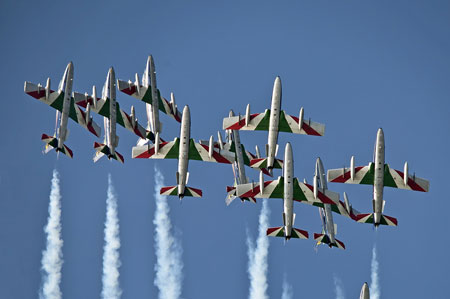
The Royal Air Force Museum is delighted to announce that it has received a confirmed grant of £898,558 from the Heritage Lottery Fund (HLF) for the creation of ‘The First World War In The Air.’ This major new exhibition, will allow museum audiences to discover and explore the unique and often overlooked role of air power during the First World War through the incredible stories of the men and women who took part.
The creation of new exhibitions and supporting activities will be delivered across the museum’s two public sites and online. It will include programmes for lifelong learning, volunteering, apprenticeships and public events. The four-year project will mark the Centenary of the First World War, exploring the development of air power as an integral part of modern warfare and end by celebrating the birth of the RAF in 2018.
London:
A brand new permanent exhibition will open in December 2014 in the museum’s historic Grahame-White Factory: this Grade II listed building was an active aircraft factory during the First World War. The Museum site in North London has a rich history and played an important role in the early development of British aviation. English aviation pioneer Claude Grahame-White described the area as ‘the birthplace of aerial power.’
Using the RAF Museum’s world-class collection of aircraft, documents, film and photographs ‘The First World War in the Air’ will reveal how aviation changed the character of war driven by innovation, sacrifice and a spirit of adventure.
The exhibition will explore what it was like to be involved in the earliest days of military aviation through the story of Britain’s air services, the Royal Flying Corps and Royal Naval Air Service. These two organisations merged on 1 April 1918 to become the world’s first independent air force, the Royal Air Force. This story will incorporate the experiences of pilots, ground crews and factory workers as well as the local North London community.
As part of this new exhibition the museum will develop unused spaces in the Grahame-White Factory. A ‘drawing office’, equipped with sketching tools, open drawers filled with facsimiles of original technical drawings and aviation-related publications, will give visitors a ‘balcony view’ of the aircraft and hangar. A community space will provide an area for the local community and volunteers to develop programmes at the museum. A new temporary exhibition gallery will enable local schools to stage a series of First World War related displays from April 2015.
Visitors will also experience improved orientation with a new signage system and landscape design, providing better connection and easier access to the building.
Cosford:
A new exhibition will be created at the museum’s site in Cosford (West Midlands) that will tell the national story of the First War in the Air using content, displays and aircraft. The exhibition will be enriched by individual stories of pilots such as ‘local hero’ pilot, Lt. Kevin Furniss, who was posted to France in April 1917. Shot down on his second mission he died as a Prisoner of War on 29 April 1917 aged 19. He was born and bought up in Trysull, a village on the outskirts of Wolverhampton and attended Wolverhampton Grammar School. The Museum will be using his story and artefacts to engage with schools, as well as in informal learning activities.
This story and others will complement new First World War themed interactive and educational activities including a linked site activity trail.
Online:
The development of an online version of the museum-based exhibition will also include the digitisation and wider public access to historical documents such as the Casualty Cards, Casualty Forms and Muster Roll, that tell the story of the men and women of the Royal Flying Corps and Royal Air Force. This will be of particular interest to genealogists and family historians.
Peter Dye, Director General of the Royal Air Force Museum: “We are delighted that the Heritage Lottery Fund has given us the support needed to tell the important story of air power in the First World War. It is of particular significance to us because of the related heritage of our London site, an active airfield and aircraft factory throughout the war, and because it embraces the birth of the Royal Air Force, built on the achievements of the Royal Flying Corps and Royal Naval Air Service. It is greatly encouraging that the public have been able to play a major part in determining the content of the new exhibition area and the selection of exhibits. As well as being a national story, the project will help the local community to understand how much their neighbourhood changed as a result of aviation and the long-term impact on their lives.”
Sue Bowers, Head of the Heritage Lottery Fund for London: “The role played by aircraft in the First World War is largely overlooked. This centenary project will redress the balance and in so doing explain how aviation itself was given a significant boost as a result of the conflict. It will also enable the wider story of the first air war pioneers and the fledgling RAF to be told.”
Helen Grant, Minister for the First World War centenary programme: “In the run up to the start of the First World War Government centenary programme I am delighted that the Heritage Lottery Fund is supporting ‘The First World War in the Air’. These enduring exhibitions will bring to life the start of air power – and the personal stories behind the aviation advances – during the war years. They will provide engaging local and national material and activities for visitors to discover and explore.”
www.rafmuseum.org





